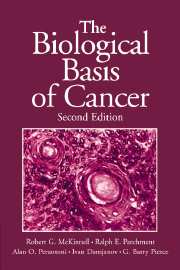Book contents
- Frontmatter
- Contents
- Preface
- Introduction: Letters illustrating clinical aspects of cancer
- 1 The pathology of cancer
- 2 Invasion and metastasis
- 3 Carcinogenesis
- 4 Genetics and heredity
- 5 Cancer-associated genes
- 6 Cancer in nonhuman organisms
- 7 Epidemiology
- 8 Lifestyle: Is there anything more important?
- 9 The stem cell basis of cancer treatment: concepts and clinical outcomes
- 10 Oncology: The difficult task of eradicating caricatures of normal tissue renewal in the human patient
- Appendix: Description of selected tumors
- Glossary
- References
- Index
- Plate section
6 - Cancer in nonhuman organisms
Published online by Cambridge University Press: 05 June 2012
- Frontmatter
- Contents
- Preface
- Introduction: Letters illustrating clinical aspects of cancer
- 1 The pathology of cancer
- 2 Invasion and metastasis
- 3 Carcinogenesis
- 4 Genetics and heredity
- 5 Cancer-associated genes
- 6 Cancer in nonhuman organisms
- 7 Epidemiology
- 8 Lifestyle: Is there anything more important?
- 9 The stem cell basis of cancer treatment: concepts and clinical outcomes
- 10 Oncology: The difficult task of eradicating caricatures of normal tissue renewal in the human patient
- Appendix: Description of selected tumors
- Glossary
- References
- Index
- Plate section
Summary
The archived specimens (in the Registry of Tumors in Lower Animals) provide historical data to establish epidemiological associations, geographic ranges and prevalence trends. It provides reference material for study by students and research scholars and provides residual material for retroactive genetics studies as new tools in molecular genetics are developed. Further, whole tumor displays in the Registry impart a convincing reality of the disabling effect of this disease on endangered species to visiting reporters, government representatives, scientists and lay public. If one picture is equal to a thousand words, an actual specimen is worth at least a hundred pictures.
J. C. Harshbarger 2002Workers who deal with cancer problems only in man and his closest relatives among the homeothermic vertebrates may look disdainfully at those who invest some of their energies in studies of neoplasms in creatures such as fish, frogs, snakes, and the numerous species of spineless, often slimy animals that were, in the days of the ancients, lumped together as “vermin.” After all, Alexander Pope, a poet of some wisdom, admonished: “The proper study of man is man.”
So it may be. But Aristotle, long before modern ecologists, recognized that man is an organism within a greater organism, the earth ecosystem. The ecosystem is not dependent on man, though man is dependent on the ecosystem. Ought not the study of man be extended to include the other animals that coexist with and support him on this motherly planet? They share with man many diseases, including cancers, and it is pertinent to ask: In what ways do neoplasms of animals at various phyletic levels differ from or resemble those of man in relation to etiology, natural history, immune factors, biochemistry, morphology, molecular biology, and the rest?
- Type
- Chapter
- Information
- The Biological Basis of Cancer , pp. 195 - 220Publisher: Cambridge University PressPrint publication year: 2006

